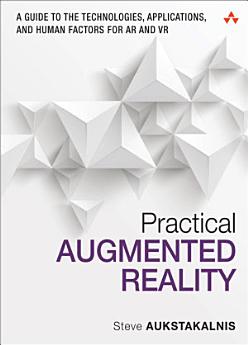Practical Augmented Reality: A Guide to the Technologies, Applications, and Human Factors for AR and VR
About this ebook
Practical Augmented Reality is ideal for practitioners and students concerned with any application, from gaming to medicine. It brings together comprehensive coverage of both theory and practice, emphasizing leading-edge displays, sensors, and DIY tools that are already available commercially or will be soon. Beginning with a Foreword by NASA research scientist Victor Luo, this guide begins by explaining the mechanics of human sight, hearing and touch, showing how these perceptual mechanisms (and their performance ranges) directly dictate the design and use of wearable displays, 3-D audio systems, and tactile/force feedback devices.
Steve Aukstakalnis presents revealing case studies of real-world applications from gaming, entertainment, science, engineering, aeronautics and aerospace, defense, medicine, telerobotics, architecture, law enforcement, and geophysics. Readers will find clear, easy-to-understand explanations, photos, and illustrations of devices including the Atheer AiR, HTC Vive, DAQRI Smart Helmet, Oculus (Facebook) CV1, Sony PlayStation VR, Vuzix M300, Google Glass, and many more. Functional diagrams and photographs clearly explain how these devices operate, and link directly to relevant theoretical and practical content.
Practical Augmented Reality thoroughly considers the human factors of these systems, including sensory and motor physiology constraints, monocular and binocular depth cues, elements contributing to visually-induced motion sickness and nausea, and vergence–accommodation conflicts. It concludes by assessing both the legal and societal implications of new and emerging AR, VR, and wearable technologies as well as provides a look next generation systems.
About the author
Steve Aukstakalnis is a former research scientist and Director of the Virtual Environment and Interactive Systems Program at the National Science Foundation's Engineering Research Center for Computational Field Simulation. There, his work focused on the application of advanced visual displays and interactive techniques in such areas as architecture, engineering, scientific visualization and national defense. He has served on the research staff at the University of Washington as well as the faculty of Mississippi State University. Steve has served an invited lecturer, instructor and researcher on the topic of virtual reality and advanced visual simulation for such organizations as the Dept. of Defense, U.S. Army, Naval Oceanographic Office, Nat'l Reconnaissance Office, University of Michigan, Pepperdine University, Purdue, Dartmouth, Nat'l Taiwan University, the Smithsonian Institution and a host of other universities, corporations and government agencies across N. America and around the world.




